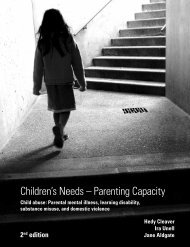Social Landlords in Scotland: Shaping up for improvement
Social Landlords in Scotland: Shaping up for improvement
Social Landlords in Scotland: Shaping up for improvement
Create successful ePaper yourself
Turn your PDF publications into a flip-book with our unique Google optimized e-Paper software.
<strong>Social</strong> <strong>Landlords</strong> <strong>in</strong> <strong>Scotland</strong>: Shap<strong>in</strong>g <strong>up</strong> <strong>for</strong> <strong>improvement</strong>.<strong>for</strong> homeless people. Where we have found poorer per<strong>for</strong>mance, these arethe recurr<strong>in</strong>g themes that underp<strong>in</strong> our <strong>in</strong>spection f<strong>in</strong>d<strong>in</strong>gs:b) a lack of clear corporate leadership;c) weaknesses <strong>in</strong> basic assessments;d) a heavy reliance on bed and breakfast temporary accommodation, andbreaches of the Unsuitable Accommodation (<strong>Scotland</strong>) Order;e) limited service user <strong>in</strong>volvement; andf) poor monitor<strong>in</strong>g of the quality of outcomes <strong>for</strong> homeless people.8.6 Scottish M<strong>in</strong>isters have set a target to reduce by 50% the number ofapplicants given non priority decisions by 2009, and to abolish the priorityneed category by 2012. At that time, all homeless people will have the rightto “settled” accommodation. Local authorities we have <strong>in</strong>spected havegenerally worked hard to try to meet this target. Many authorities haverecognised the importance of hav<strong>in</strong>g a strong emphasis on prevent<strong>in</strong>ghomelessness <strong>in</strong> the first place and prevent<strong>in</strong>g its recurrence. We have seena number of <strong>in</strong>novative approaches and projects focused on help<strong>in</strong>gpreviously homeless people to susta<strong>in</strong> their accommodation, particularly <strong>in</strong>services <strong>for</strong> young people. But there are challenges <strong>for</strong> a number of localauthorities <strong>in</strong> achiev<strong>in</strong>g the 2012 target. Some local authorities that operate<strong>in</strong> pressured hous<strong>in</strong>g markets are reach<strong>in</strong>g a level of social lets to homelesspeople beyond which it may not be susta<strong>in</strong>able to go.8.7 One way <strong>for</strong> local authorities to try to manage some of this pressure is to workwith RSLs to house more homeless people. As a result of the Hous<strong>in</strong>g(<strong>Scotland</strong>) Act 2001, RSLs are legally obliged to comply with requests fromlocal authorities to accommodate homeless households assessed as be<strong>in</strong>gun<strong>in</strong>tentionally homeless and <strong>in</strong> priority need. There is a strongly held beliefamongst RSLs that this obligation has resulted <strong>in</strong> a huge <strong>in</strong>crease <strong>in</strong> theproportion of new tenancies granted to homeless applicants, and acorrespond<strong>in</strong>g rise <strong>in</strong> the proportion of tenants with social s<strong>up</strong>port needs andantisocial behaviour. And, <strong>in</strong>deed, a number of RSLs are now hous<strong>in</strong>gconsiderably more homeless people than <strong>in</strong> the past. However, overall, theproportion of RSL lets go<strong>in</strong>g to homeless people referred by local authoritieshas, <strong>in</strong> fact, <strong>in</strong>creased only slowly over the last four years and accounted <strong>for</strong>21% of all RSL lets <strong>in</strong> 2007/08.49

















